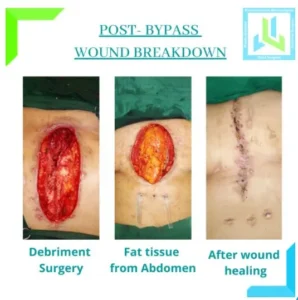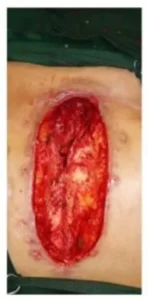Post- Bypass Wound Breakdown
Patient Review
- Patient’s Name: Anonyms
- Patient’s Age: 65
- Patient’s Gender: female
Symptoms
- Post- Bypass Wound Breakdown
Case Presentation
Heart Bypass surgery is a lifesaving procedure done following symptoms like a heart attack when it is diagnosed the blood supply to different parts of the heart is reduced due to the narrowing of blood vessels supplying blood to the heart.
For bypass surgery, the chest is opened in the midline and surgery is performed. Following this surgery, the wound may take a long time to heal, especially in women due to the weight of breasts stretching the suture line. In some patients, the wound does not heal and opens up exposing the underlying bone- sternum and other tissues.
These wounds have the potential to become infected, hence, need to be treated early and diligently so as to prevent infection and promote healing. Such wounds are called sternal dehiscence or opening up of the sternal wound.
These patients are then referred to the Plastic Surgeon for wound management. The wound is managed in two or three stages. To begin with, the wound is evaluated for its depth, quantum and type of infection and presence of non-living tissues. A CT scan is performed routinely to assess all these.
The first stage consists of cleaning up the wound and is called Debridement; following debridement the wound is closed with a special type of dressing called Negative pressure wound dressing wherein a vacuum is created to facilitate better healing.
As the wounding quality improves in 5-10 days, the patient is then taken up for definitive surgery. Most often than not, flap surgery is done to close the wound; wherein healthy tissue is taken from elsewhere in the body and used to fill the cavity of the wound and close it completely. This facilitates complete closure of the wound and optimal healing.


Case Study on Post Bypass Wound Breakdown:

The upper end apparently continued to heal but the lower end opening seemed to go deeper towards the bone.
We counselled her for the need for a two-stage surgery to which she agreed.
The first stage was debridement – cleaning up the wound and removing all necrotic and unhealthy tissue. The second stage was covering the wound with a healthy flap taken from the abdomen. The wound then went on to heal uneventfully.
As the wounding quality improves in 5-10 days, the patient is then taken up for definitive surgery. Most often than not, flap surgery is done to close the wound; wherein healthy tissue is taken from elsewhere in the body and used to fill the cavity of the wound and close it completely. This facilitates complete closure of the wound and optimal healing.
Post-surgery 2 years and she is doing fine.
Treatment and prognosis
- Post- Bypass Wound Breakdown
- CT scan
Physical Examination & Tests
- Post- Bypass Wound Break
